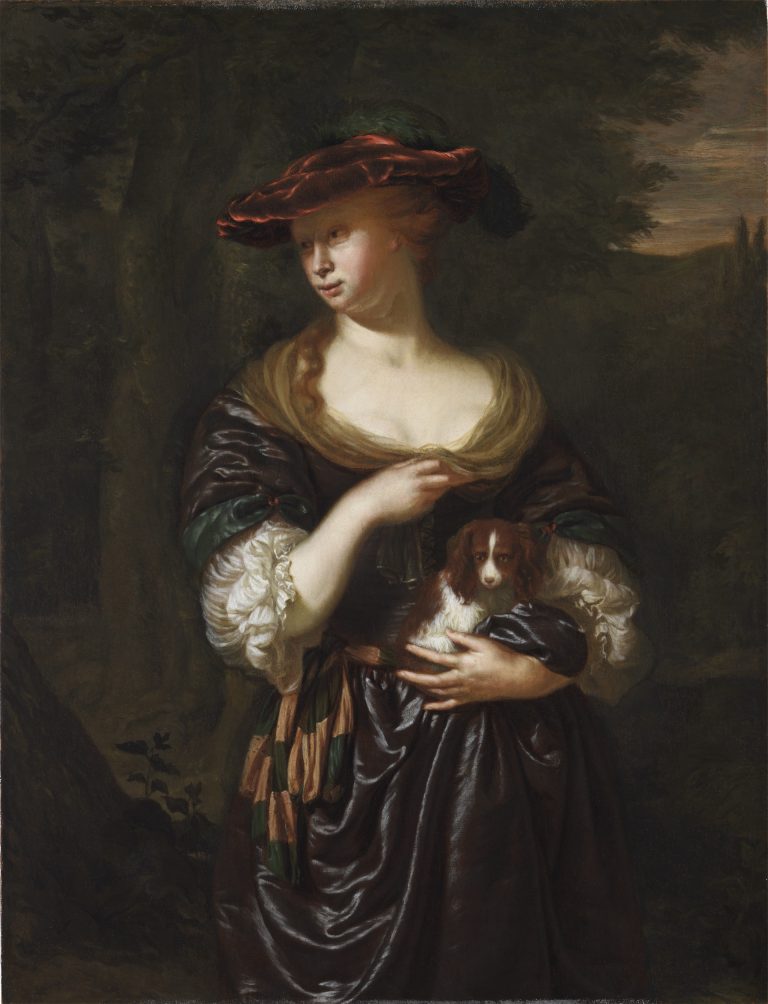An elegantly dressed woman stands in a dimly lit wooded landscape beneath a rose-colored evening sky. She gently embraces her lap dog while, with her right hand, gracefully fingering the thin, taupe scarf wrapped loosely around the low neckline of her dark, shimmering dress.1 As she gazes toward the left, her young face is partly shaded by her stylish red velvet beret, the lustrous, soft texture and subtle sheen of which the artist has rendered with special care.
This picture was formerly attributed to Jan’s father, Frans van Mieris the Elder (1635–81), whose later work displays similarly strong chiaroscuro effects and robust highlights.2 Jan van Mieris, who was apprenticed to his father along with his brother Willem, produced a number of genre pictures in his father’s manner during the early 1680s that are stylistically related to the present work.3 A similar woman, for example, appears in A Woman Reading a Letter and Men Playing Tric-Trac beneath a Portico (fig 1) and Training the Little Dog (ca. 1680).4 In each of these paintings, she strikes a comparable pose, with a frontal view of her upper body and her head turned to the right as she gazes somewhat downward, and she even holds her dog in an analogous manner. Particularly in the latter picture, the woman’s dress and the rendering of highlights are remarkably similar. Woman Holding a Dog in a Landscape was probably painted a few years later, when Jan van Mieris began to focus on single figures in the open air, as in, for example, his Smoking Man, dated 1685.5 In this painting he similarly situated his sitter before a wooded landscape with dimly lit trees silhouetting the evening sky.
The elegant manner in which the woman holds her scarf and her little dog reveals Van Mieris’s interest in classicism at this stage of his career. According to Van Gool, Frans the Elder initially considered sending Jan to Amsterdam to learn from Gerard de Lairesse (1640–1711), the leading classicist painter and art theorist, though ultimately he changed his mind.6 Although Jan never did study with Lairesse, he probably became involved in the circle of Amsterdam artists and art devotees who sympathized with Lairesse’s principles. Jan’s allegory, Minerva as Patron of the Arts, dated 1685, was in fact inspired by Lairesse’s prominent series of five allegories in grisaille the artist painted for the textile magnate Philips de Flines, who lived on the Herengracht in Amsterdam.7
As he stated in his Groot schilderboek (1707), Lairesse believed that classical form and beauty were essential not only for history painting but also for the representation of everyday life. He wrote: “gracefulness,” which consists of the ideal form and proper proportions of the human body elevated in ancient sculptures, “must indispensably be perceived in modern representations.”8 Whether this gracefulness was successfully incorporated into the female figure in the picture or not,9 Jan van Mieris became increasingly keen to learn directly from works by ancient and modern artists in Italy, and he departed for that country in 1688. Unfortunately, he soon fell ill and died at the age of thirty, just a few years after he arrived in Rome.
